WHS Act & Safety Breaches: A Case Study of Kenoss Company Fatality
VerifiedAdded on 2023/06/04
|8
|2373
|427
Essay
AI Summary
This essay analyzes the breaches of safety rules by Kenoss Company that led to the death of a truck driver, Michael Booth, in 2012. The analysis includes a description of the workplace, the hazards present, and how the serious electrical incident (SEI) could have been prevented. The event is explained, along with WorkSafe's involvement in the resolution. The essay also discusses potential actions that could have been taken to address the safety issues, such as implementing safety signs, managing site access, and conducting subcontractor inductions. Furthermore, the strategic management plan of the corporation, documentation, and systematic approach to safety are analyzed. The charges against Kenoss Contractors and a senior manager are examined in light of the WHS Act, along with the contribution of SafeWork ACT. The essay concludes by emphasizing the importance of prioritizing safety and health in the workplace to prevent future incidents and ensure compliance with work health and safety laws.
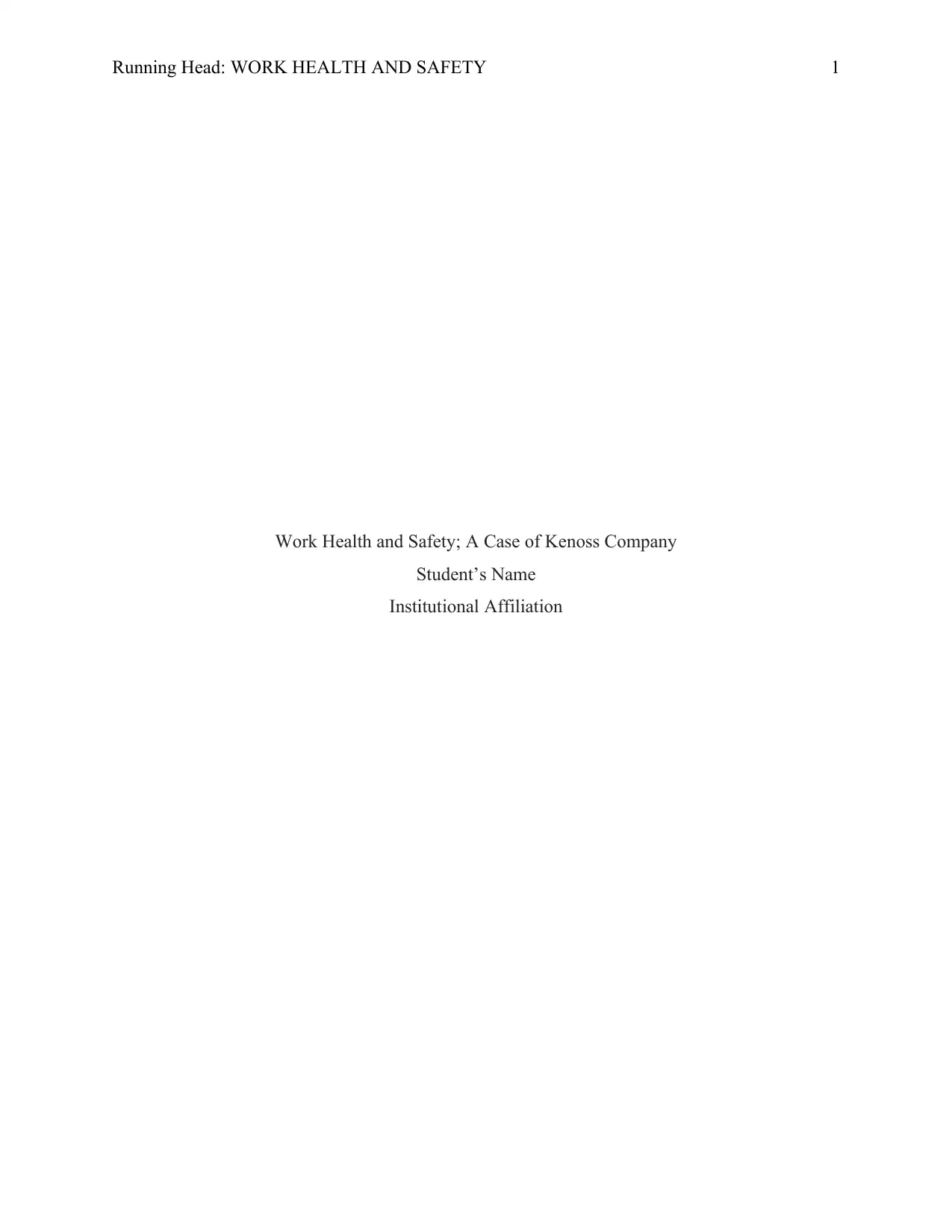
Running Head: WORK HEALTH AND SAFETY 1
Work Health and Safety; A Case of Kenoss Company
Student’s Name
Institutional Affiliation
Work Health and Safety; A Case of Kenoss Company
Student’s Name
Institutional Affiliation
Paraphrase This Document
Need a fresh take? Get an instant paraphrase of this document with our AI Paraphraser
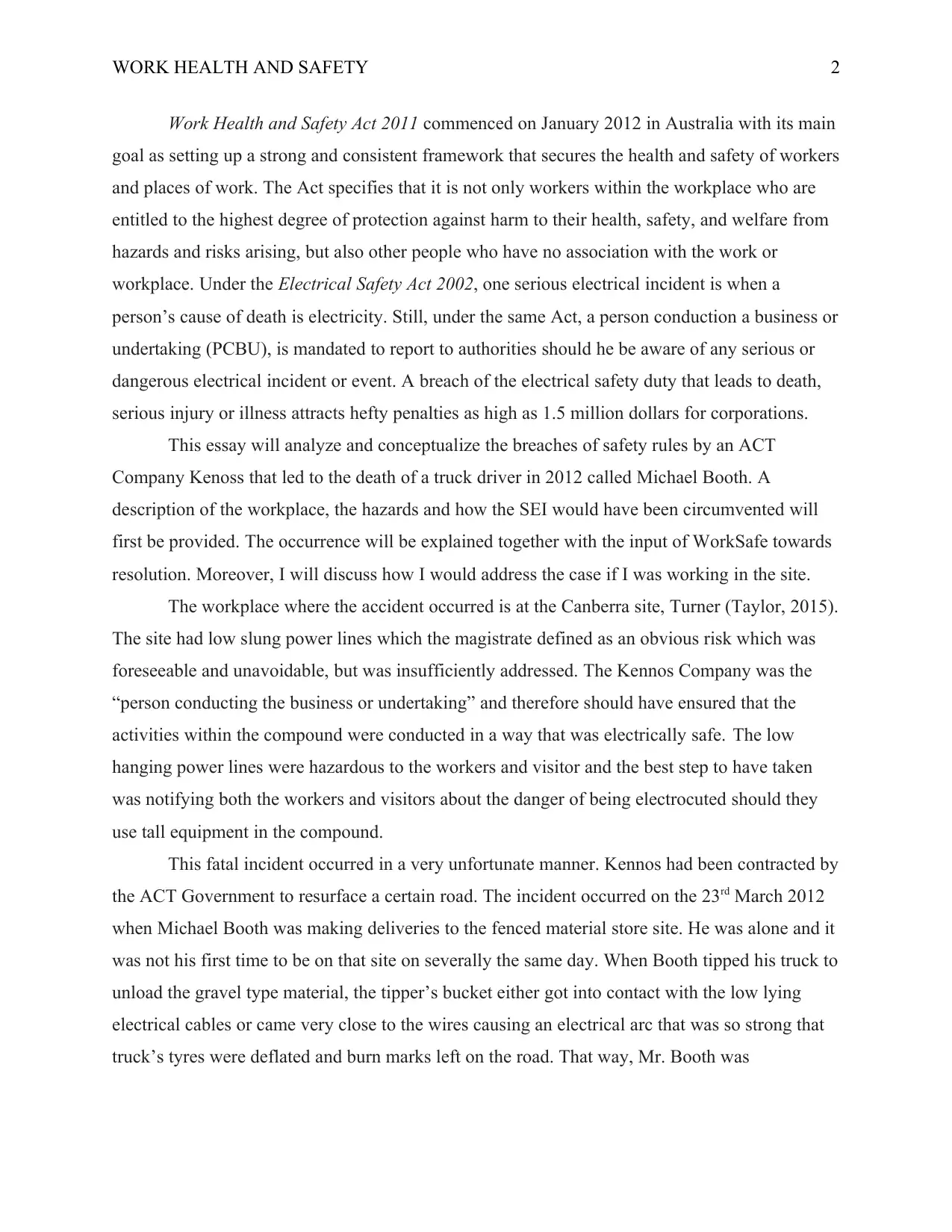
WORK HEALTH AND SAFETY 2
Work Health and Safety Act 2011 commenced on January 2012 in Australia with its main
goal as setting up a strong and consistent framework that secures the health and safety of workers
and places of work. The Act specifies that it is not only workers within the workplace who are
entitled to the highest degree of protection against harm to their health, safety, and welfare from
hazards and risks arising, but also other people who have no association with the work or
workplace. Under the Electrical Safety Act 2002, one serious electrical incident is when a
person’s cause of death is electricity. Still, under the same Act, a person conduction a business or
undertaking (PCBU), is mandated to report to authorities should he be aware of any serious or
dangerous electrical incident or event. A breach of the electrical safety duty that leads to death,
serious injury or illness attracts hefty penalties as high as 1.5 million dollars for corporations.
This essay will analyze and conceptualize the breaches of safety rules by an ACT
Company Kenoss that led to the death of a truck driver in 2012 called Michael Booth. A
description of the workplace, the hazards and how the SEI would have been circumvented will
first be provided. The occurrence will be explained together with the input of WorkSafe towards
resolution. Moreover, I will discuss how I would address the case if I was working in the site.
The workplace where the accident occurred is at the Canberra site, Turner (Taylor, 2015).
The site had low slung power lines which the magistrate defined as an obvious risk which was
foreseeable and unavoidable, but was insufficiently addressed. The Kennos Company was the
“person conducting the business or undertaking” and therefore should have ensured that the
activities within the compound were conducted in a way that was electrically safe. The low
hanging power lines were hazardous to the workers and visitor and the best step to have taken
was notifying both the workers and visitors about the danger of being electrocuted should they
use tall equipment in the compound.
This fatal incident occurred in a very unfortunate manner. Kennos had been contracted by
the ACT Government to resurface a certain road. The incident occurred on the 23rd March 2012
when Michael Booth was making deliveries to the fenced material store site. He was alone and it
was not his first time to be on that site on severally the same day. When Booth tipped his truck to
unload the gravel type material, the tipper’s bucket either got into contact with the low lying
electrical cables or came very close to the wires causing an electrical arc that was so strong that
truck’s tyres were deflated and burn marks left on the road. That way, Mr. Booth was
Work Health and Safety Act 2011 commenced on January 2012 in Australia with its main
goal as setting up a strong and consistent framework that secures the health and safety of workers
and places of work. The Act specifies that it is not only workers within the workplace who are
entitled to the highest degree of protection against harm to their health, safety, and welfare from
hazards and risks arising, but also other people who have no association with the work or
workplace. Under the Electrical Safety Act 2002, one serious electrical incident is when a
person’s cause of death is electricity. Still, under the same Act, a person conduction a business or
undertaking (PCBU), is mandated to report to authorities should he be aware of any serious or
dangerous electrical incident or event. A breach of the electrical safety duty that leads to death,
serious injury or illness attracts hefty penalties as high as 1.5 million dollars for corporations.
This essay will analyze and conceptualize the breaches of safety rules by an ACT
Company Kenoss that led to the death of a truck driver in 2012 called Michael Booth. A
description of the workplace, the hazards and how the SEI would have been circumvented will
first be provided. The occurrence will be explained together with the input of WorkSafe towards
resolution. Moreover, I will discuss how I would address the case if I was working in the site.
The workplace where the accident occurred is at the Canberra site, Turner (Taylor, 2015).
The site had low slung power lines which the magistrate defined as an obvious risk which was
foreseeable and unavoidable, but was insufficiently addressed. The Kennos Company was the
“person conducting the business or undertaking” and therefore should have ensured that the
activities within the compound were conducted in a way that was electrically safe. The low
hanging power lines were hazardous to the workers and visitor and the best step to have taken
was notifying both the workers and visitors about the danger of being electrocuted should they
use tall equipment in the compound.
This fatal incident occurred in a very unfortunate manner. Kennos had been contracted by
the ACT Government to resurface a certain road. The incident occurred on the 23rd March 2012
when Michael Booth was making deliveries to the fenced material store site. He was alone and it
was not his first time to be on that site on severally the same day. When Booth tipped his truck to
unload the gravel type material, the tipper’s bucket either got into contact with the low lying
electrical cables or came very close to the wires causing an electrical arc that was so strong that
truck’s tyres were deflated and burn marks left on the road. That way, Mr. Booth was
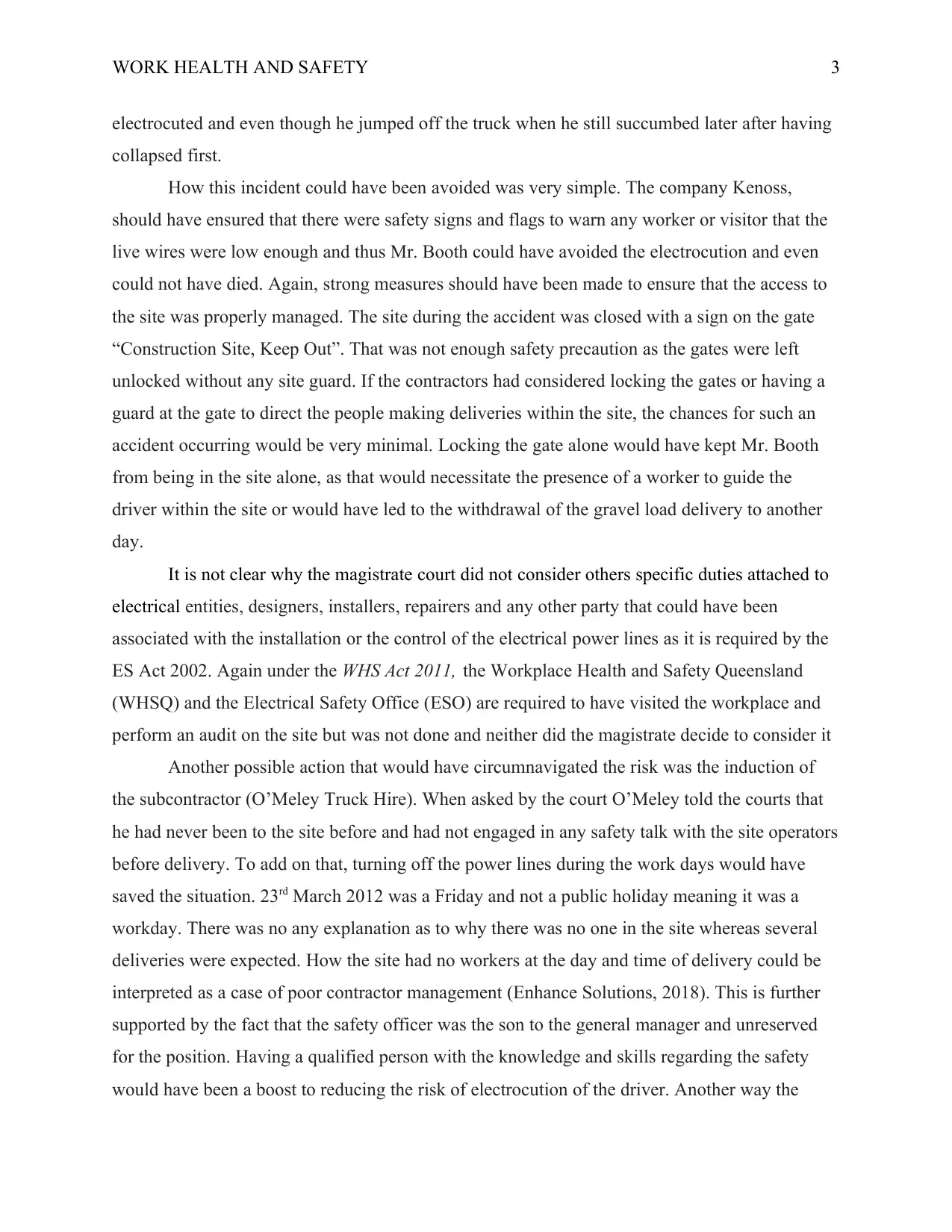
WORK HEALTH AND SAFETY 3
electrocuted and even though he jumped off the truck when he still succumbed later after having
collapsed first.
How this incident could have been avoided was very simple. The company Kenoss,
should have ensured that there were safety signs and flags to warn any worker or visitor that the
live wires were low enough and thus Mr. Booth could have avoided the electrocution and even
could not have died. Again, strong measures should have been made to ensure that the access to
the site was properly managed. The site during the accident was closed with a sign on the gate
“Construction Site, Keep Out”. That was not enough safety precaution as the gates were left
unlocked without any site guard. If the contractors had considered locking the gates or having a
guard at the gate to direct the people making deliveries within the site, the chances for such an
accident occurring would be very minimal. Locking the gate alone would have kept Mr. Booth
from being in the site alone, as that would necessitate the presence of a worker to guide the
driver within the site or would have led to the withdrawal of the gravel load delivery to another
day.
It is not clear why the magistrate court did not consider others specific duties attached to
electrical entities, designers, installers, repairers and any other party that could have been
associated with the installation or the control of the electrical power lines as it is required by the
ES Act 2002. Again under the WHS Act 2011, the Workplace Health and Safety Queensland
(WHSQ) and the Electrical Safety Office (ESO) are required to have visited the workplace and
perform an audit on the site but was not done and neither did the magistrate decide to consider it
Another possible action that would have circumnavigated the risk was the induction of
the subcontractor (O’Meley Truck Hire). When asked by the court O’Meley told the courts that
he had never been to the site before and had not engaged in any safety talk with the site operators
before delivery. To add on that, turning off the power lines during the work days would have
saved the situation. 23rd March 2012 was a Friday and not a public holiday meaning it was a
workday. There was no any explanation as to why there was no one in the site whereas several
deliveries were expected. How the site had no workers at the day and time of delivery could be
interpreted as a case of poor contractor management (Enhance Solutions, 2018). This is further
supported by the fact that the safety officer was the son to the general manager and unreserved
for the position. Having a qualified person with the knowledge and skills regarding the safety
would have been a boost to reducing the risk of electrocution of the driver. Another way the
electrocuted and even though he jumped off the truck when he still succumbed later after having
collapsed first.
How this incident could have been avoided was very simple. The company Kenoss,
should have ensured that there were safety signs and flags to warn any worker or visitor that the
live wires were low enough and thus Mr. Booth could have avoided the electrocution and even
could not have died. Again, strong measures should have been made to ensure that the access to
the site was properly managed. The site during the accident was closed with a sign on the gate
“Construction Site, Keep Out”. That was not enough safety precaution as the gates were left
unlocked without any site guard. If the contractors had considered locking the gates or having a
guard at the gate to direct the people making deliveries within the site, the chances for such an
accident occurring would be very minimal. Locking the gate alone would have kept Mr. Booth
from being in the site alone, as that would necessitate the presence of a worker to guide the
driver within the site or would have led to the withdrawal of the gravel load delivery to another
day.
It is not clear why the magistrate court did not consider others specific duties attached to
electrical entities, designers, installers, repairers and any other party that could have been
associated with the installation or the control of the electrical power lines as it is required by the
ES Act 2002. Again under the WHS Act 2011, the Workplace Health and Safety Queensland
(WHSQ) and the Electrical Safety Office (ESO) are required to have visited the workplace and
perform an audit on the site but was not done and neither did the magistrate decide to consider it
Another possible action that would have circumnavigated the risk was the induction of
the subcontractor (O’Meley Truck Hire). When asked by the court O’Meley told the courts that
he had never been to the site before and had not engaged in any safety talk with the site operators
before delivery. To add on that, turning off the power lines during the work days would have
saved the situation. 23rd March 2012 was a Friday and not a public holiday meaning it was a
workday. There was no any explanation as to why there was no one in the site whereas several
deliveries were expected. How the site had no workers at the day and time of delivery could be
interpreted as a case of poor contractor management (Enhance Solutions, 2018). This is further
supported by the fact that the safety officer was the son to the general manager and unreserved
for the position. Having a qualified person with the knowledge and skills regarding the safety
would have been a boost to reducing the risk of electrocution of the driver. Another way the
⊘ This is a preview!⊘
Do you want full access?
Subscribe today to unlock all pages.

Trusted by 1+ million students worldwide
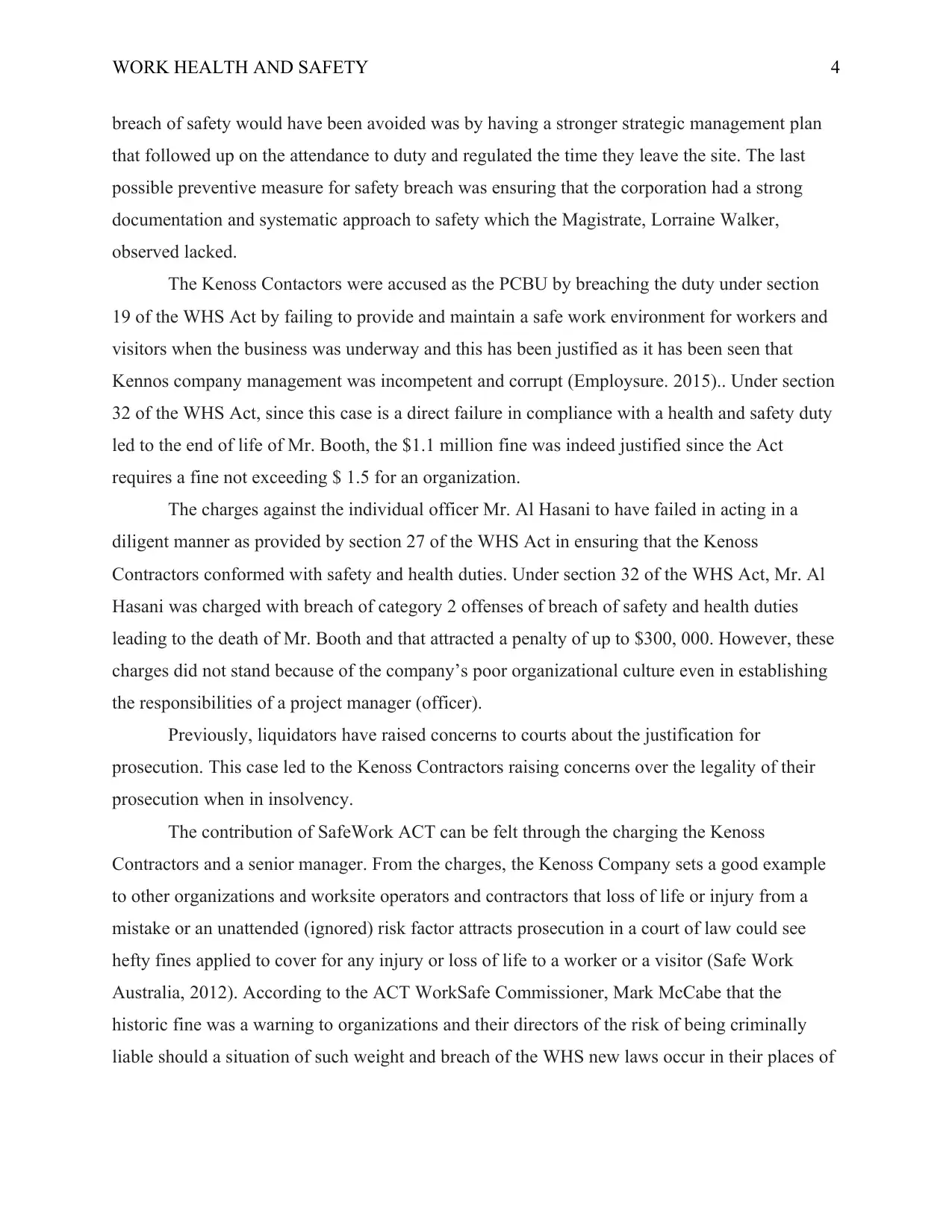
WORK HEALTH AND SAFETY 4
breach of safety would have been avoided was by having a stronger strategic management plan
that followed up on the attendance to duty and regulated the time they leave the site. The last
possible preventive measure for safety breach was ensuring that the corporation had a strong
documentation and systematic approach to safety which the Magistrate, Lorraine Walker,
observed lacked.
The Kenoss Contactors were accused as the PCBU by breaching the duty under section
19 of the WHS Act by failing to provide and maintain a safe work environment for workers and
visitors when the business was underway and this has been justified as it has been seen that
Kennos company management was incompetent and corrupt (Employsure. 2015).. Under section
32 of the WHS Act, since this case is a direct failure in compliance with a health and safety duty
led to the end of life of Mr. Booth, the $1.1 million fine was indeed justified since the Act
requires a fine not exceeding $ 1.5 for an organization.
The charges against the individual officer Mr. Al Hasani to have failed in acting in a
diligent manner as provided by section 27 of the WHS Act in ensuring that the Kenoss
Contractors conformed with safety and health duties. Under section 32 of the WHS Act, Mr. Al
Hasani was charged with breach of category 2 offenses of breach of safety and health duties
leading to the death of Mr. Booth and that attracted a penalty of up to $300, 000. However, these
charges did not stand because of the company’s poor organizational culture even in establishing
the responsibilities of a project manager (officer).
Previously, liquidators have raised concerns to courts about the justification for
prosecution. This case led to the Kenoss Contractors raising concerns over the legality of their
prosecution when in insolvency.
The contribution of SafeWork ACT can be felt through the charging the Kenoss
Contractors and a senior manager. From the charges, the Kenoss Company sets a good example
to other organizations and worksite operators and contractors that loss of life or injury from a
mistake or an unattended (ignored) risk factor attracts prosecution in a court of law could see
hefty fines applied to cover for any injury or loss of life to a worker or a visitor (Safe Work
Australia, 2012). According to the ACT WorkSafe Commissioner, Mark McCabe that the
historic fine was a warning to organizations and their directors of the risk of being criminally
liable should a situation of such weight and breach of the WHS new laws occur in their places of
breach of safety would have been avoided was by having a stronger strategic management plan
that followed up on the attendance to duty and regulated the time they leave the site. The last
possible preventive measure for safety breach was ensuring that the corporation had a strong
documentation and systematic approach to safety which the Magistrate, Lorraine Walker,
observed lacked.
The Kenoss Contactors were accused as the PCBU by breaching the duty under section
19 of the WHS Act by failing to provide and maintain a safe work environment for workers and
visitors when the business was underway and this has been justified as it has been seen that
Kennos company management was incompetent and corrupt (Employsure. 2015).. Under section
32 of the WHS Act, since this case is a direct failure in compliance with a health and safety duty
led to the end of life of Mr. Booth, the $1.1 million fine was indeed justified since the Act
requires a fine not exceeding $ 1.5 for an organization.
The charges against the individual officer Mr. Al Hasani to have failed in acting in a
diligent manner as provided by section 27 of the WHS Act in ensuring that the Kenoss
Contractors conformed with safety and health duties. Under section 32 of the WHS Act, Mr. Al
Hasani was charged with breach of category 2 offenses of breach of safety and health duties
leading to the death of Mr. Booth and that attracted a penalty of up to $300, 000. However, these
charges did not stand because of the company’s poor organizational culture even in establishing
the responsibilities of a project manager (officer).
Previously, liquidators have raised concerns to courts about the justification for
prosecution. This case led to the Kenoss Contractors raising concerns over the legality of their
prosecution when in insolvency.
The contribution of SafeWork ACT can be felt through the charging the Kenoss
Contractors and a senior manager. From the charges, the Kenoss Company sets a good example
to other organizations and worksite operators and contractors that loss of life or injury from a
mistake or an unattended (ignored) risk factor attracts prosecution in a court of law could see
hefty fines applied to cover for any injury or loss of life to a worker or a visitor (Safe Work
Australia, 2012). According to the ACT WorkSafe Commissioner, Mark McCabe that the
historic fine was a warning to organizations and their directors of the risk of being criminally
liable should a situation of such weight and breach of the WHS new laws occur in their places of
Paraphrase This Document
Need a fresh take? Get an instant paraphrase of this document with our AI Paraphraser
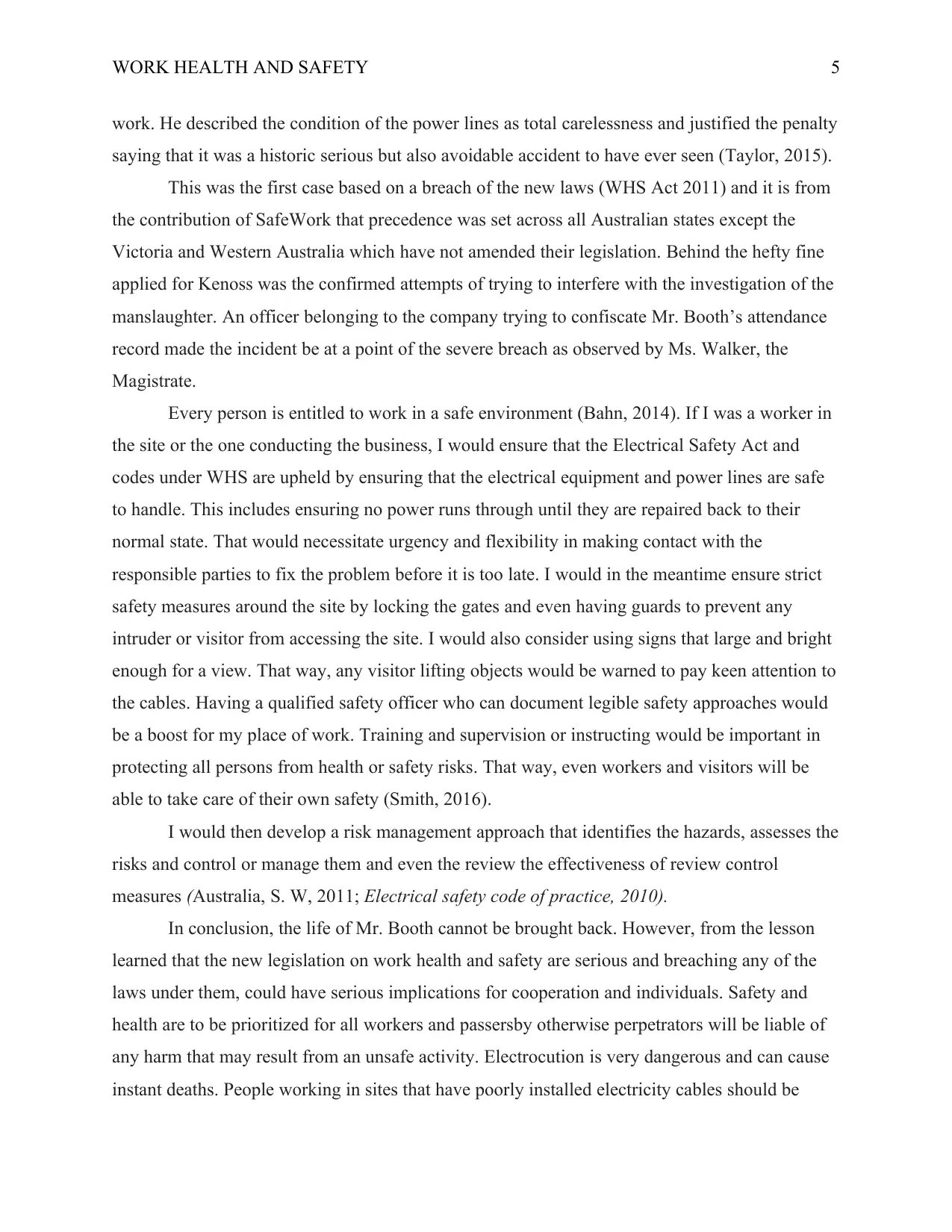
WORK HEALTH AND SAFETY 5
work. He described the condition of the power lines as total carelessness and justified the penalty
saying that it was a historic serious but also avoidable accident to have ever seen (Taylor, 2015).
This was the first case based on a breach of the new laws (WHS Act 2011) and it is from
the contribution of SafeWork that precedence was set across all Australian states except the
Victoria and Western Australia which have not amended their legislation. Behind the hefty fine
applied for Kenoss was the confirmed attempts of trying to interfere with the investigation of the
manslaughter. An officer belonging to the company trying to confiscate Mr. Booth’s attendance
record made the incident be at a point of the severe breach as observed by Ms. Walker, the
Magistrate.
Every person is entitled to work in a safe environment (Bahn, 2014). If I was a worker in
the site or the one conducting the business, I would ensure that the Electrical Safety Act and
codes under WHS are upheld by ensuring that the electrical equipment and power lines are safe
to handle. This includes ensuring no power runs through until they are repaired back to their
normal state. That would necessitate urgency and flexibility in making contact with the
responsible parties to fix the problem before it is too late. I would in the meantime ensure strict
safety measures around the site by locking the gates and even having guards to prevent any
intruder or visitor from accessing the site. I would also consider using signs that large and bright
enough for a view. That way, any visitor lifting objects would be warned to pay keen attention to
the cables. Having a qualified safety officer who can document legible safety approaches would
be a boost for my place of work. Training and supervision or instructing would be important in
protecting all persons from health or safety risks. That way, even workers and visitors will be
able to take care of their own safety (Smith, 2016).
I would then develop a risk management approach that identifies the hazards, assesses the
risks and control or manage them and even the review the effectiveness of review control
measures (Australia, S. W, 2011; Electrical safety code of practice, 2010).
In conclusion, the life of Mr. Booth cannot be brought back. However, from the lesson
learned that the new legislation on work health and safety are serious and breaching any of the
laws under them, could have serious implications for cooperation and individuals. Safety and
health are to be prioritized for all workers and passersby otherwise perpetrators will be liable of
any harm that may result from an unsafe activity. Electrocution is very dangerous and can cause
instant deaths. People working in sites that have poorly installed electricity cables should be
work. He described the condition of the power lines as total carelessness and justified the penalty
saying that it was a historic serious but also avoidable accident to have ever seen (Taylor, 2015).
This was the first case based on a breach of the new laws (WHS Act 2011) and it is from
the contribution of SafeWork that precedence was set across all Australian states except the
Victoria and Western Australia which have not amended their legislation. Behind the hefty fine
applied for Kenoss was the confirmed attempts of trying to interfere with the investigation of the
manslaughter. An officer belonging to the company trying to confiscate Mr. Booth’s attendance
record made the incident be at a point of the severe breach as observed by Ms. Walker, the
Magistrate.
Every person is entitled to work in a safe environment (Bahn, 2014). If I was a worker in
the site or the one conducting the business, I would ensure that the Electrical Safety Act and
codes under WHS are upheld by ensuring that the electrical equipment and power lines are safe
to handle. This includes ensuring no power runs through until they are repaired back to their
normal state. That would necessitate urgency and flexibility in making contact with the
responsible parties to fix the problem before it is too late. I would in the meantime ensure strict
safety measures around the site by locking the gates and even having guards to prevent any
intruder or visitor from accessing the site. I would also consider using signs that large and bright
enough for a view. That way, any visitor lifting objects would be warned to pay keen attention to
the cables. Having a qualified safety officer who can document legible safety approaches would
be a boost for my place of work. Training and supervision or instructing would be important in
protecting all persons from health or safety risks. That way, even workers and visitors will be
able to take care of their own safety (Smith, 2016).
I would then develop a risk management approach that identifies the hazards, assesses the
risks and control or manage them and even the review the effectiveness of review control
measures (Australia, S. W, 2011; Electrical safety code of practice, 2010).
In conclusion, the life of Mr. Booth cannot be brought back. However, from the lesson
learned that the new legislation on work health and safety are serious and breaching any of the
laws under them, could have serious implications for cooperation and individuals. Safety and
health are to be prioritized for all workers and passersby otherwise perpetrators will be liable of
any harm that may result from an unsafe activity. Electrocution is very dangerous and can cause
instant deaths. People working in sites that have poorly installed electricity cables should be

WORK HEALTH AND SAFETY 6
more careful to avoid the fatal results from unsafe contact with them. The WHS new laws will
assuredly promote a safer working environment for all people across Australia.
more careful to avoid the fatal results from unsafe contact with them. The WHS new laws will
assuredly promote a safer working environment for all people across Australia.
⊘ This is a preview!⊘
Do you want full access?
Subscribe today to unlock all pages.

Trusted by 1+ million students worldwide

WORK HEALTH AND SAFETY 7
References
Australia, S. W. (2011). How to manage work health and safety risks: Code of practice. Safe
Work Australia.
Bahn, S. T. (2014). OHS management: Contemporary issues in Australia.
Electrical Safety Act 2002 11 (Aust.)
Electrical safety code of practice, 2010
Employsure. (2015). Breach Of Workplace Safety Results In Tragic Death |. Employsure.
Retrieved 5 October 2018, from https://employsure.com.au/blog/put-a-stop-to-workplace-
injury-and-fatality/
Enhance Solutions. (2018). Poor Safety Culture and Lack of Systems Lead to Fatality | Enhance
Solutions. Retrieved 5 October 2018, from
http://www.enhancesolutions.com.au/blog/poor-safety-culture-and-lack-of-systems-lead-
to-fatality
Safe Work Australia. (2012). Australian work health and safety strategy 2012-2022: Healthy,
safe and productive working lives. Safe Work Australia.
Smith, G. W. (2016). Management Obligations for Health and Safety. CRC Press.
Taylor G. (2015). Canberra construction company fined $1.1m over death of truck driver. ABC
News. Retrieved 5 October 2018, from
http://www.abc.net.au/news/2015-08-19/construction-company-fined-1-million-over-
workplace-death/6708032
Utz C. (2015) Work Health and Safety In Australia; A Harmonised Approach. Retrieved 5
October 2018, https://www.claytonutz.com/ArticleDocuments/178/Clayton-Utz-Work-
Health-and-Safety-in-Australia-2015.pdf.aspx?Embed=Y
Work Health and Safety Act 2011 . (2018). Legislation.gov.au. Retrieved 5 October 2018, from
https://www.legislation.gov.au/Details/C2017C00305
Work Health and Safety Act 2011 19 (Austl.)
Work Health and Safety Act 2011 27 (Austl.)
Work Health and Safety Act 2011 32 (Austl.)
References
Australia, S. W. (2011). How to manage work health and safety risks: Code of practice. Safe
Work Australia.
Bahn, S. T. (2014). OHS management: Contemporary issues in Australia.
Electrical Safety Act 2002 11 (Aust.)
Electrical safety code of practice, 2010
Employsure. (2015). Breach Of Workplace Safety Results In Tragic Death |. Employsure.
Retrieved 5 October 2018, from https://employsure.com.au/blog/put-a-stop-to-workplace-
injury-and-fatality/
Enhance Solutions. (2018). Poor Safety Culture and Lack of Systems Lead to Fatality | Enhance
Solutions. Retrieved 5 October 2018, from
http://www.enhancesolutions.com.au/blog/poor-safety-culture-and-lack-of-systems-lead-
to-fatality
Safe Work Australia. (2012). Australian work health and safety strategy 2012-2022: Healthy,
safe and productive working lives. Safe Work Australia.
Smith, G. W. (2016). Management Obligations for Health and Safety. CRC Press.
Taylor G. (2015). Canberra construction company fined $1.1m over death of truck driver. ABC
News. Retrieved 5 October 2018, from
http://www.abc.net.au/news/2015-08-19/construction-company-fined-1-million-over-
workplace-death/6708032
Utz C. (2015) Work Health and Safety In Australia; A Harmonised Approach. Retrieved 5
October 2018, https://www.claytonutz.com/ArticleDocuments/178/Clayton-Utz-Work-
Health-and-Safety-in-Australia-2015.pdf.aspx?Embed=Y
Work Health and Safety Act 2011 . (2018). Legislation.gov.au. Retrieved 5 October 2018, from
https://www.legislation.gov.au/Details/C2017C00305
Work Health and Safety Act 2011 19 (Austl.)
Work Health and Safety Act 2011 27 (Austl.)
Work Health and Safety Act 2011 32 (Austl.)
Paraphrase This Document
Need a fresh take? Get an instant paraphrase of this document with our AI Paraphraser

WORK HEALTH AND SAFETY 8
1 out of 8
Related Documents
Your All-in-One AI-Powered Toolkit for Academic Success.
+13062052269
info@desklib.com
Available 24*7 on WhatsApp / Email
![[object Object]](/_next/static/media/star-bottom.7253800d.svg)
Unlock your academic potential
Copyright © 2020–2025 A2Z Services. All Rights Reserved. Developed and managed by ZUCOL.




